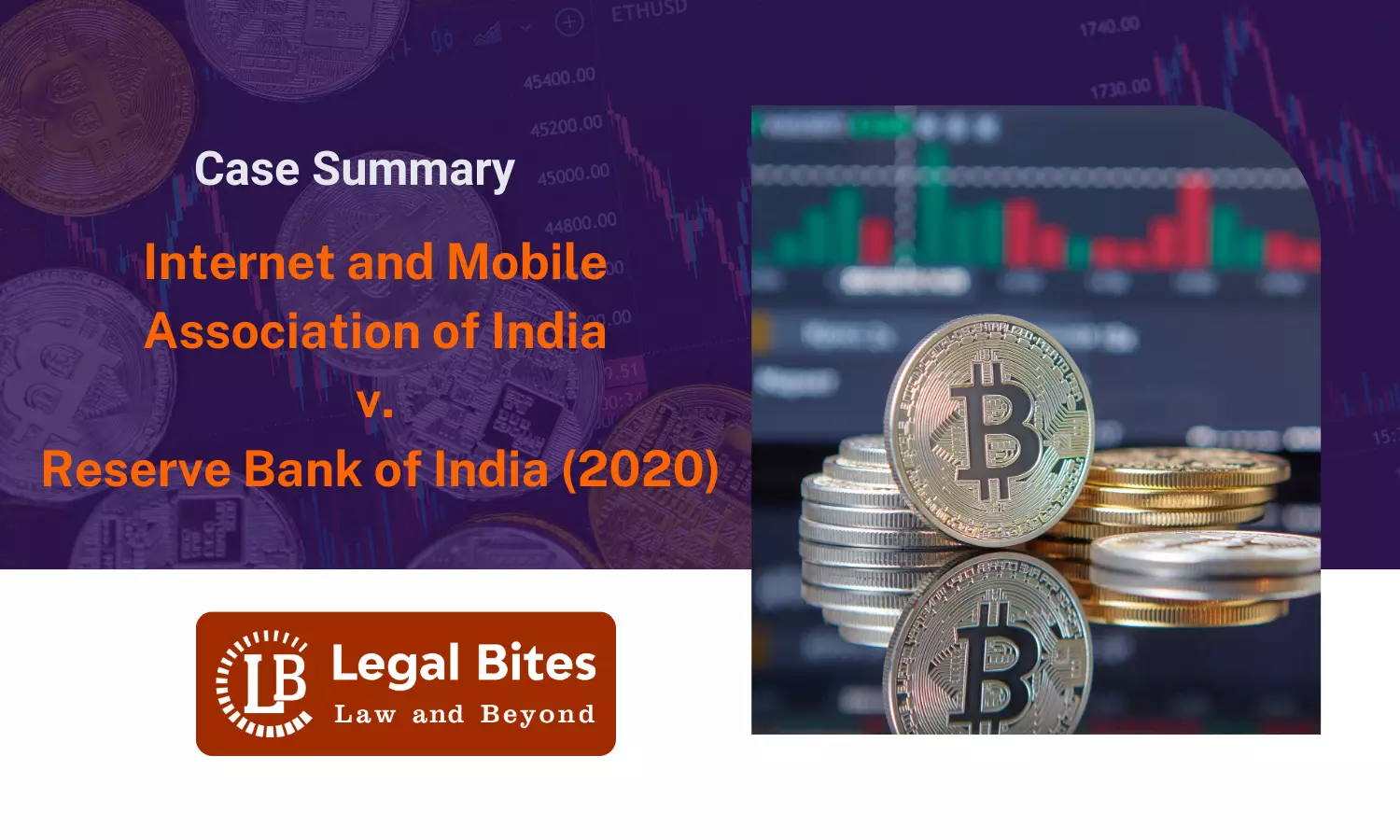Case Summary: Internet and Mobile Association of India v Reserve Bank of India (2020) | Cryptocurrency Case
This case marked a win for India's crypto industry, affirming RBI's regulations must be proportionate, evidence-based, and respect fundamental rights.

This case is seen as a landmark ruling for the cryptocurrency industry in India, restoring the ability of exchanges to operate and pushing the debate on cryptocurrency regulation in India to the forefront.
Case Title: Internet and Mobile Association of India v. Reserve Bank of India
Citation: Writ Petition (Civil) No.528 of 2018
Bench: Justice Rohinton Fali Nariman, Justice Aniruddha Bose & Justice V. Ramasubramanian
Date of Judgment: March 4th, 2020
Introduction and Background of the Case
The Internet and Mobile Association of India (IMAI) challenged the RBI's circular issued on April 6, 2018, which prohibited banks from providing services to individuals or businesses involved in trading virtual currencies (cryptocurrencies). The RBI cited concerns regarding financial risks, money laundering, and the potential use of cryptocurrencies for illegal activities, such as terrorism financing. However, the Supreme Court found that the circular lacked a legislative basis and violated the fundamental rights of individuals and businesses under Article 19(1)(g) of the Indian Constitution, which guarantees the right to practice any profession or carry on any occupation, trade, or business.
Facts of the Case
The RBI’s circular instructed all entities regulated by it to:
- Refrain from offering services to individuals or companies dealing in cryptocurrencies.
- Terminate relationships with entities involved in trading or settling virtual currencies.
The IMAI argued that cryptocurrencies were not legal tender but rather commodities, and thus the RBI lacked authority to regulate them. The IMAI also asserted that the circular infringed upon their fundamental rights by disproportionately restricting their trade and business activities. The RBI defended its actions, citing the risks associated with virtual currencies and its power under the Banking Regulation Act, 1949, to regulate such transactions.
Issues Raised Before the Court
- Whether the RBI had the authority to regulate virtual currencies, given that they were not legal tender but tradable commodities.
- Whether the RBI’s circular infringed upon the fundamental rights of the petitioners under Article 19(1)(g) of the Constitution of India.
Arguments from the Appellant Side
The IMAI contended that:
- The RBI’s circular was not legally justified as virtual currencies were not recognized as legal tender, and hence, the RBI lacked the authority to regulate or restrict their trade.
- The circular imposed an unreasonable restriction on the right to conduct trade or business under Article 19(1)(g) of the Constitution.
- The circular could have severe economic consequences, potentially driving the cryptocurrency trade underground.
Arguments from the Respondent Side
The RBI argued that:
- It had the authority to regulate cryptocurrencies under the Banking Regulation Act, 1949, the Reserve Bank of India Act, 1934, and the Payment and Settlement Systems Act, 2007.
- The circular did not violate fundamental rights, as it provided a reasonable time frame (three months) for businesses to comply.
- Virtual currencies could potentially disrupt the financial system, and therefore, the RBI had a duty to safeguard the interests of the public and the stability of the economy.
Judgment
The Supreme Court observed that the RBI had the authority to regulate the country’s monetary and financial systems, including the management of virtual currencies, as per the Banking Regulation Act, 1949, and the RBI Act, 1934. However, the court also acknowledged that cryptocurrencies, while not legal tender, could still be traded as commodities and did not fall entirely outside the regulatory framework.
The court ruled that the circular
- did not completely ban the use of cryptocurrencies but only restricted banks from offering services to entities involved in cryptocurrency trading.
- was disproportionate, as the RBI failed to demonstrate adequate harm or risk posed by cryptocurrencies that justified such an extensive restriction.
- violated the petitioners’ rights under Article 19(1)(g) by imposing an unfair and excessive restriction on their ability to trade in virtual currencies.
Consequently, the court quashed the RBI circular, allowing banks to resume offering services related to cryptocurrency trading.
The court referred to State of Maharashtra v. Indian Hotel and Restaurant Association, wherein the harm incurred by the petitioner was considered when ruling in their favor. This principle of proportionality was applied in the present case as well.
Conclusion
The Supreme Court’s decision in Internet and Mobile Association of India v. Reserve Bank of India marked a significant ruling in the regulation of cryptocurrencies in India. By declaring the RBI’s circular unconstitutional, the court reinforced the principle that restrictions imposed by regulatory bodies must be proportionate and based on sound legal grounds. This case also highlighted the evolving regulatory framework around emerging technologies like cryptocurrencies.

